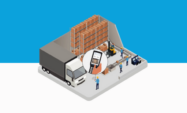Wholesale Distribution
Filter By
Browse By
- SAP Analytics and AI
- SAP Application Development and Integration
- All SAP Application Development and Integration
- SAP ABAP
- SAP ABAP Development Tools
- SAP ABAP Test Cockpit
- SAP API Management
- SAP BAPI
- SAP Basis
- SAP BRF
- SAP Business Application Studio
- SAP CMS
- SAP Design Studio
- SAP Development Tools
- SAP DevOps
- SAP EAI
- SAP EDI
- SAP Extension Suite
- SAP Fiori
- SAP Fiori Elements
- SAP Integration Suite
- SAP Low Code Application Development
- SAP Low Code Automation
- SAP Netweaver
- SAP Release Management
- SAP UI5
- SAP Web Application Server
- SAP Web IDE
- SAP Business Process Management
- SAP Center of Excellence
- SAP CIO
- SAP Customer Experience
- SAP Data and Data Management
- All SAP Data and Data Management
- SAP BW
- SAP BW/4HANA
- SAP Crystal Reporting
- SAP Data Archiving
- SAP Data Center
- SAP Data Governance
- SAP Data Integration
- SAP Data Migration
- SAP Data Quality
- SAP Data Services
- SAP Data Strategy
- SAP Data Visualization
- SAP Data Warehouse Cloud
- SAP DMS
- SAP Document Control
- SAP EIM
- SAP ETL
- SAP ETL Tools
- SAP HANA
- SAP HANA Administration
- SAP HANA Deployment Infrastructure
- SAP HANA Studio
- SAP Master Data
- SAP Master Data Governance
- SAP MDM
- SAP Enterprise Architect
- SAP Enterprise Asset Management
- SAP ERP
- SAP Finance
- All SAP Finance
- SAP Accounting
- SAP AR AP
- SAP Asset Accounting
- SAP Billing Systems
- SAP BPC
- SAP BRIM
- SAP Cash Management
- SAP Central Finance
- SAP Controlling
- SAP COPA
- SAP Cost Center Accounting
- SAP e-invoicing
- SAP FICO
- SAP Finance Automation
- SAP Financial Closing Cockpit
- SAP Financial Consolidation
- SAP Financial Planning
- SAP FX Risk
- SAP General Ledger
- SAP Global Tax Management
- SAP Hyperion
- SAP Order to Cash
- SAP Payment Processing
- SAP Profitability Analysis
- SAP Rebate Management
- SAP S/4HANA Finance
- SAP Universal Journal
- SAP Governance Risk and Compliance
- SAP Human Capital Management
- SAP Intelligent Technologies
- SAP Platform and Technology
- All SAP Platform and Technology
- SAP Business Technology Platform
- SAP Cloud Connector
- SAP Cloud Integration Platform
- SAP Cloud Migration
- SAP Cloud Platform
- SAP Cloud Providers
- SAP Cloud Strategy
- SAP Container Platform
- SAP Digital Asset Management
- SAP Digital Integration Hub
- SAP Digital Signature
- SAP HANA Enterprise Cloud
- SAP HEC
- SAP Hyperscalers
- SAP Infrastructure
- SAP Messaging
- SAP Smart Forms
- SAP Quality and Testing
- SAP Security
- SAP Spend Management
- SAP Supply Chain Management
- All SAP Supply Chain Management
- SAP APO
- SAP Asset Management
- SAP Business Network
- SAP Digital Manufacturing Cloud
- SAP Digital Twin
- SAP EWM
- SAP IBP
- SAP Inventory Management
- SAP Label Printing
- SAP Logistics
- SAP Manufacturing
- SAP Manufacturing Automation
- SAP MES
- SAP MII
- SAP MM
- SAP MRO
- SAP MRP
- SAP Order Management
- SAP Plant Maintenance
- SAP PLM
- SAP Production Planning
- SAP S&OP
- SAP SD
- SAP SPM
- SAP Supply Chain Planning
- SAP Track and Trace
- SAP Transportation Management
- SAP System Administration
The wholesale industry acts as an important link in the global supply chain and is responsible for distributing most products among business partners around the world. By definition, a wholesaler buys products in bulk from a manufacturer or supplier and sells them to customers at wholesale prices. Customers are often commercial facilities, traders, or retail stores. Wholesalers maintain strong relationships both upstream and downstream in the supply chain. Upstream, retailers maintain relationships with their suppliers. Suppliers are often manufacturers of products that are stocked and distributed by wholesalers. Distributors typically buy goods in bulk from manufacturers and suppliers, disassemble large quantities of goods, store them in distribution centers, and finally at wholesale prices for various companies, contractors, hospitals, restaurants, retailers.
SAP and Partner Technologies for Wholesale
SAP and partner technology solutions allow wholesale vendors to pursue new sales sources, find efficiency opportunities and build differentiating capabilities through digital transformation. These technical solutions are available in the following areas:
The wholesale industry acts as an important link in the global supply chain and is responsible for distributing most products among business partners around the world. By definition, a wholesaler buys products in bulk from a manufacturer or supplier and sells them to customers at wholesale prices. Customers are often commercial facilities, traders, or retail stores. Wholesalers maintain strong relationships both upstream and downstream in the supply chain. Upstream, retailers maintain relationships with their suppliers. Suppliers are often manufacturers of products that are stocked and distributed by wholesalers. Distributors typically buy goods in bulk from manufacturers and suppliers, disassemble large quantities of goods, store them in distribution centers, and finally at wholesale prices for various companies, contractors, hospitals, restaurants, retailers.
SAP and Partner Technologies for Wholesale
SAP and partner technology solutions allow wholesale vendors to pursue new sales sources, find efficiency opportunities and build differentiating capabilities through digital transformation. These technical solutions are available in the following areas:
- Procurement solutions help in areas like buy buying and delivering services, goods procurement, cost recovery, procurement analytics, source and contract, supplier management etc.
- Supply chain planning solutions in wholesale distribution helps distributors with demand management and insights, response and supply planning, sales, inventory and operations planning
- Supply chain execution solutions assist in areas like order promising, logistics network track and trace, transportation management, warehouse and yard management
- Sales and marketing solutions help wholesalers perform commerce personalization, manage customer rebates and incentives better, build omnichannel commerce management capabilities and sales force automation.
- Service solutions help in areas like buy & deliver services, field services management, subscription management, customer experience management etc.
Key Considerations for SAP Organizations
- Building competitive differentiators with SAP S/4HANA– View this webinar on-demand to learn how successful Wholesaler Distributors are using SAP S/4HANA and RISE to address challenges facing the industry and differentiate themselves from the competition.
-
Transforming business operations with private cloud– Learn how when GraceKennedy Limited needed to upgrade its infrastructure to support its international expansion and increase its performance and reliability, it turned to the private cloud. The results have delivered significant value to the business and freed its IT personnel to work on higher-level tasks that provide greater impact.
McKesson Ensures Business Continuity While Accelerating Innovation –
– This article highlights how McKesson, a healthcare wholesale distribution company transformed its business operations leveraging SAP technologies.
5 results
-

PreBilt™ – EP Group Case Study
Reading time: 1 mins
EP Group significantly improved warehouse efficiency and productivity by transitioning from manual paper processes to an intuitive mobile solution, PreBilt™, which utilizes voice and scanning technology, resulting in three times more productivity and immediate benefits in stock accuracy and availability.
-

- SAP Order to Cash
 Premium
Premium
SAP Customers Struggle to Maximize Full SAP Cash and Treasury Functionality
Published: 25/August/2023
Reading time: 4 mins
Although tools such as SAP’s Cash Management and Treasury are crucial in driving business growth, many businesses have yet to explore the full potential of such tools and their functionalities. Preliminary insights from SAPinsider’s upcoming Cash Management and Visibility research confirm that many organizations still use legacy SAP ERP systems with classic tools, SAP Cash...…
-
Case Study: CONA Services HXM Move from SAP On-Premise to ECP
Published: 12/May/2023
Reading time: 1 min
Coke One North America (CONA) Services, the provider of collaborative tools for Coca-Cola Company’s largest bottling partners, successfully migrated from SAP On-Premise to Employee Central Payroll (ECP) using the Nexus Powered “lift-and-shift” approach. By leveraging the Nexus Suite, CONA Services achieved a fast and cost-effective migration, saving significant time and effort. The migration enabled CONA…
-
-

PreBilt™ for EWM – Deli Home Case Study
Published: 11/April/2023
Reading time: 1 mins
Deli Home, a supplier of custom timber products for the home improvement market, deployed a rapid deployment mobile solution called PreBilt to extend SAP Extended Warehouse Management (EWM) to its warehouses in the Netherlands. Initially, Deli Home was exploring a low-code platform to build a mobile solution but found that it would have delayed the…
-

Dare to Compare: The Evolution of the Voice Solution Architecture
Published: 08/December/2022
Reading time: 1 min
One of the biggest changes in the past few years has been around the performance of voice recognition in noisy warehouse environments. Previously, this was the main competitive differentiator, but it’s not 2009 anymore. Due to significant technology and data computing advancements, modern voice recognition solutions have leapfrogged the previous generation.
Become a Member
Unlimited access to thousands of resources for SAP-specific expertise that can only be found here.
Related Vendors
Your request has been successfully sent

